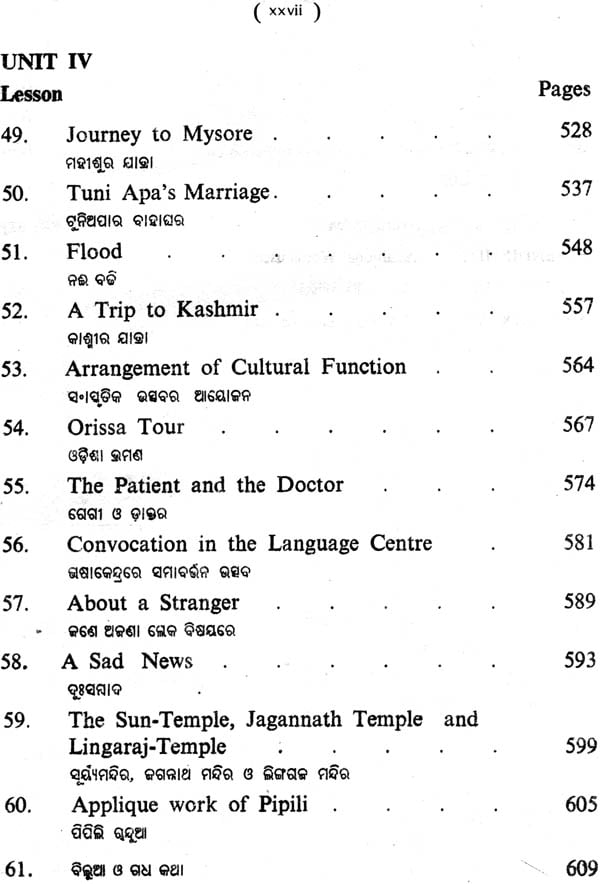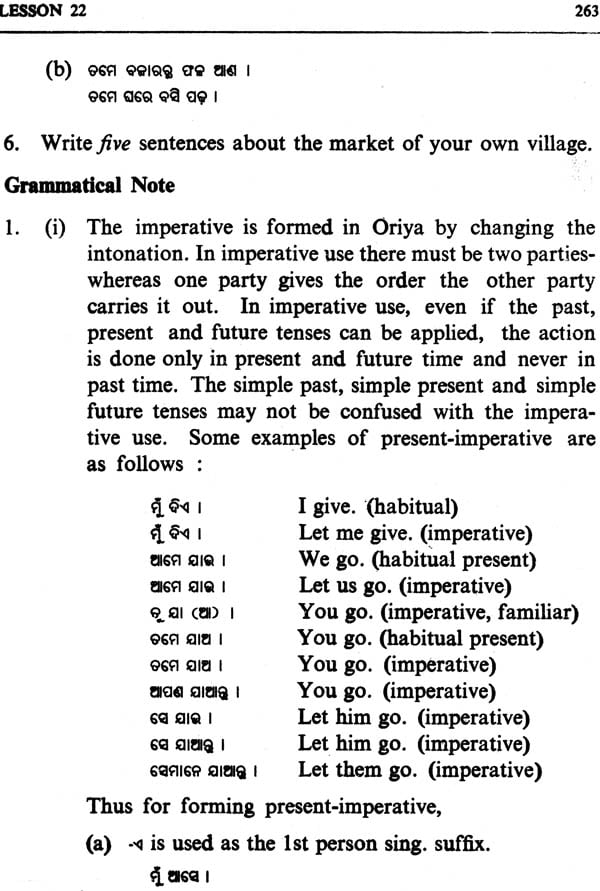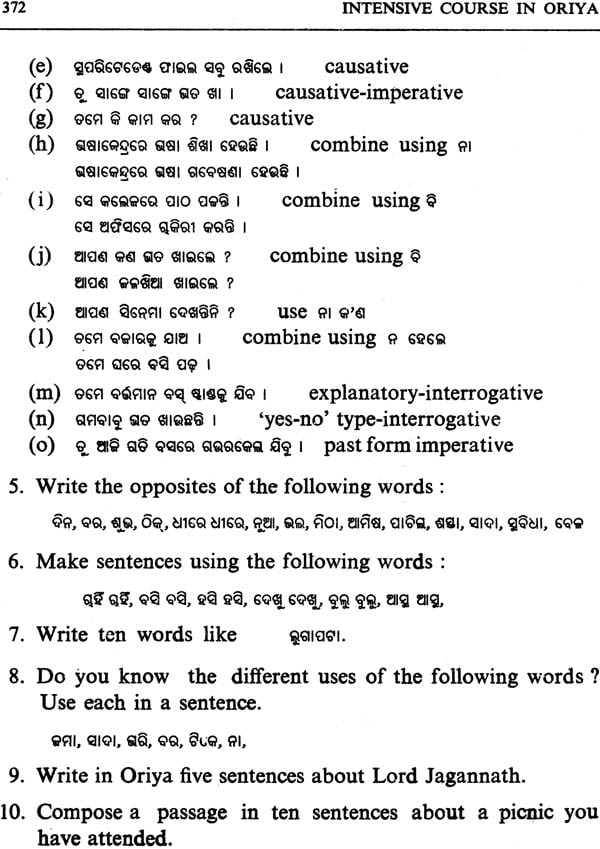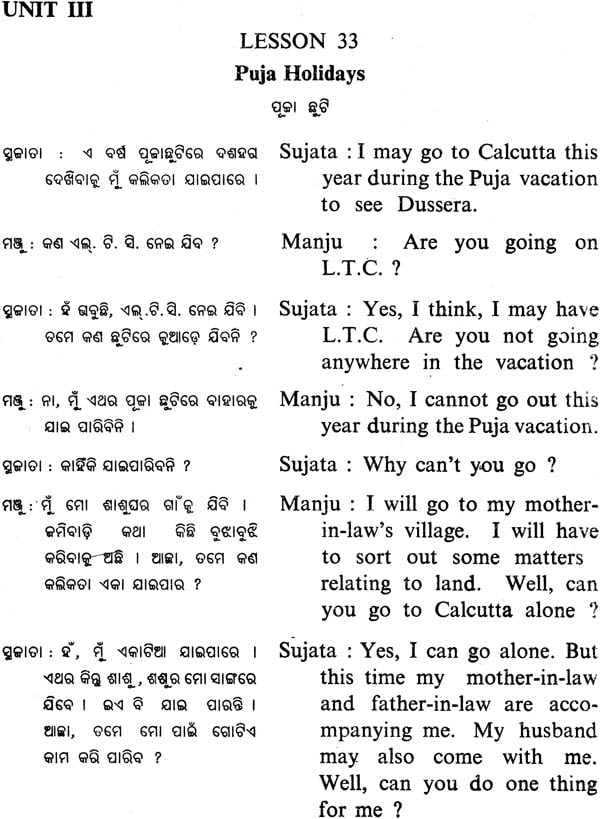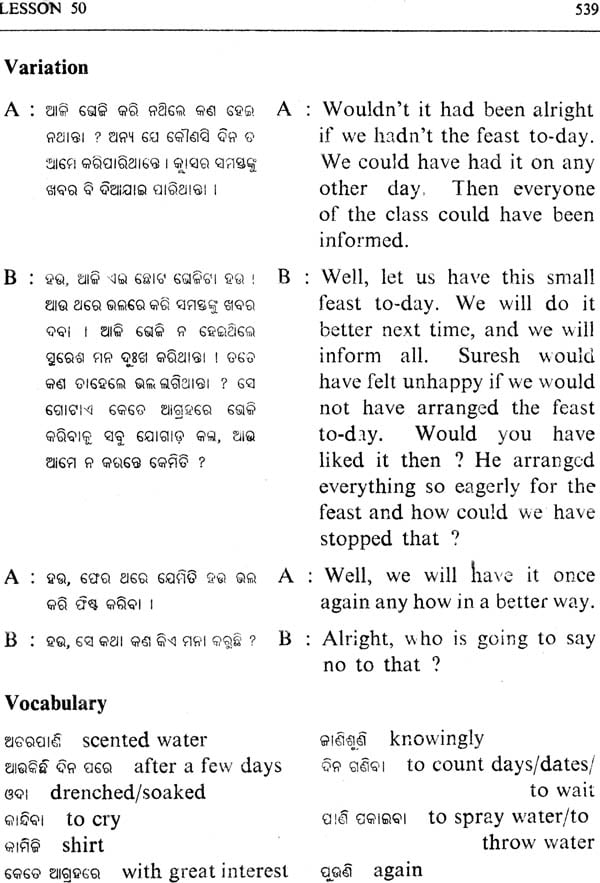
An Intensive Course in Oriya
Book Specification
| Item Code: | NAK160 |
| Author: | Bijayalaxmi Mohanty |
| Publisher: | Central Institute Of Indian Languages, Mysore |
| Edition: | 2010 |
| Pages: | 710 |
| Cover: | Hardcover |
| Other Details | 9.0 inch x 7.0 inch |
| Weight | 990 gm |
Book Description
The Central Institute of Indian Languages was set up on the 17th July. 1969 with a view to assisting and co-ordinating the development of Indian language. The Institute was charged with the responsibility of serving as a nucleus to bring together all the research and literary output from the various linguistic streams to a common head narrowing the gap between basic research in the fields of languages and linguistics in India.
The Institute and its seven Regional Language Centres are thus engaged in research and teaching which lead to the publication of a wide ranging variety of materials. Preparation of materials designed for teaching/learning at different levels and suited to specific needs is one of the major areas of interest of the Institute. Basic research relating to the acquisition of language and study of language in its manifold psycho-social relations constitute another broad range of its interest. The publication will include materials produced by the members of the staff of the Central Institute of Indian Language and its Regional Language Centres and associated scholars from Universities and Institutions both Indian and foreign.
The Central Institute of Indian Language has initiated an Basic Course Series in major Indian languages to provide suitable and comprehensive material for learning and teaching the language concerned for Indian. In a language teaching situation, the teacher is expected to combine the roles of a psycho-linguist, socio-linguist, linguist, language pedagogue, a creator of materials, a literary critic and a testing and evaluation expert. Most of his competences are naturally reflected in the materials, which simultaneously are graded from simple to complex, known to the unknown and contrived to the natural. This is a very difficult task. After research and experimeantation we have come out with more questions than answers at each stage of the material. For example, how basic is basic? What is grading? In what way can linguistic and cultural matter be graded? Is question with which most learning begins, simpler than statement? How does one move from a purely language based competence to creating literary sensibilities? How does one build into the material conceptual prose? How are lessons to be presented? Should the translated discourse structure be made to look similar to the original discourse structure? Questions such as these have been answered differently by different teachers and researchers. This search is a continuing phenomenon. Therefore, these materials represent our unfinished education in this area.
The format of the basic course is the result of a consensus arrived at by the Conference of Principals and lecturers of the Regional Language Centres of the Institute. Conversational Oriya by Pattanayak and Dash provided a model for this. About eight years of class room trail provided the flexibility to innovate. Early sections of the book were given to Sri G. N. Dash for vetting. Comments of Sri Dash were taken into consideration while finalising the manuscript. Smt. Bijayalaxmi. Mohanty has taken meticulous care i preparing the text. She deserves all commendations. I congratulate the teachers, trainees, the people from the press and publication unit of the Institute who are responsible for the neat execution of the book. If the course stimulates further work on the Oriya language and benefits those wishing to learn Oriya as a second/foreign language, then the Institute's efforts would have been rewarded.
An Intensive Course in Oriya aims at providing materials to facilitate teaching of Oriya as a second/foreign language to adult learners whose mother tongues are other than Oriya and it forms part of the total process pursued with such aims by the C.I.I.L., Mysore. In preparing this book I owe my gratitude to Dr. D. P. Pattanayak, former Director, C.I.I.L., Mysore, but for whose valuable guidance and supervision, from time to time, the book would not have got its present shape.
I am extremely grateful to Dr. M. S. Thirumalai Deputy Director C.I.I.L. and the General Editor for the C.I.I.L. Intensive Course Series, for guiding me in the preparation of the book including its general format and technical details and in seeing through its final printing by the Govt. of India Text Book Press. Bhubaneswar, and the Publication Unit of the C.I.I.L. My gratitude to Dr. M. S. Thirumalai is immense and will always remain so.
I am grateful to Dr. Appanna Pradhan, former Principal, E. R. L. C. for his kind co-operatio encouragement and keen interest in seeing that this book is printed properly and in time.
I am grateful to Dr. G.N Das, Professor, Department of Linguistics, Berhampur University Berhampur, for his vetting and useful suggestions.
I am thankful to Dr. A. Pattanayak, Senior Lecturer in Oriya, E.R.L.C. for his co-operation while I was writing this book. I thank my erstwhile colleague, Smt. Trupti Mohanty of E.R.L.C. who helped me a lot while I was writing the Book.
I also thank my students with whom the contents of the book were first tried out and by whom I was really much benefited though teaching and in preparing the book.
I am thankful to my colleagues of Assamese and Bengali Departments who have directly or indirectly helped me with their useful suggestions and discussions for preparing this book.
I immensely thank Sri Naredranath Sarangi, the Oriya typist, for typing the manuscript of the book several times and preparing the press copy in spite of his other preoccupations and indifferent health. I sincerely thank the Librarian Smt. A. Mishra and L.L.T., Mr.P.I. Mathai and all the members of the staff of the office who are either directly or indirectly involved in some way or other with this book while it was under preparation. I am most thankful to Mr. Gyan Singh, and Mr. Y. Viswanathan, the Managers, Mr. N. L. Majumdar and Mr. K.K. Biswas, deputy Managers and the members of the Govt, of India Text Book Press, Bhubaneswar for their co-operation and involvement. It is only because of their sincere efforts the art-pulls of his book could be broughtout so neatly and perfectly. My special thanks are due to Mr. B.N. Mukherjee, Editor, Mr J. N. Kanungo Reader, Mr. U. N. Sahoo, Copy – Holder, Mr. R. K. Mohanty, Mono-Operator, Mr S. Sahoo, Artist, Mr. R. K. Mohanty, Mono-Operator, Mr. S. Sahoo, Artist, Mr. S. N. Panda, Section Holder, Mr. B. K. Rout Compositor and Mr. S. Sahoo, Compositor.
I am also thankful to the publication Unit of the Institute, C.I.I.L. Mysore, for printing and publishing this book. I also thank Mr. Barik, Artist, C.I.I.L. Mysore for Drawing the Oriya alphabet for the book.
I most humbly admit that I am responsible for any flaw to be found anywhere in the book. I shall be extremely happy if this book is found useful for the second/foreign language learners of the language. I will appreciate if the readers would send their critical comments with suggestions for further improvement of the Book.
Finally, I express my gratitude to my husband, Prof, J. M. Mohanty. Head of the Department of English, Utkal University, Bhundaneswar for his continuous support while I was preparing this book and his meticulous care in bringing out this book in its present shape. To him this book is dedicated.
There are a large number of language in the Indian sub-continent and they create many problems, beginning from communication to linguistic. To solve and minimize these problems and to promote national integration among the people of India the phenomena of language learning has an important role to play.
Learning a second language of foreign language by conscious and deliberate efforts within a specified period by an individual in different from the acquisition of mother – tongue by a child in his early childhood by indeliberate and somehow natural slow process. The child is exposed to the environment of the mother – tongue and picks up the language in a slow and gradual process, that is, he himself listens, selects and grades the language items he is able to grasp from the environment of the language he lives in. Sometimes even the child is capable of acquitting more than one language at a time from different language environments. But for learning a new language at a later stage by an individual within a specified time, exposure to the environment of the concerned language is necessary. Along with it proper motivation on the part of the learner, carefully planned and prospered instructional materials, classroom facilities, and the need for competent instructors or language teachers are also necessary for successful results.
Keeping in view this conscious attempt to learn Oriya as a second foreign language by the adult learners in a classroom set-up within in a specified period has been made in this book to provide instructional material following the principle of selection gradation and presentation of the language items. The teachable items have been carefully selected graded and presented pedagogically on the basis of a progression made from simple to complex, from known to unknown or from less difficult elements of the language. it is hoped the learners, equipped with these instructional material, would find themselves in a better position the language in a graded manner within a specified period.
Main objects
The instructional material as contained in An Intensive Course in Oriya have been prepared keeping in view the need of the learners in the Easterb Regional Language Centre of the Central Institute of Indian Languages. These learners are usually non-Oriya of the School teachers form different provinces of India, and the book is intended to be used in the first phase of the three phase-course of 10 months intensive language training programme of 1100 hours of instruction. The first phase on the Basic Course covers a period of 14 weeks, i.e. 450 instructional hours. At the end of the Basic Course, the learners are to achieve the following objective:
1. Be able to perceive and reproduce orally the sounds of the language and to identify as well as discriminate those sounds in their meaningful sequence,
2. Be able to form simple sentences orally from given patterns and lexical items from the real life situations,
3. Be able to converse with the teacher and with fellow trainees on specified topics under controlled situation following real life situations,
4. Be able to narrate specified events and topics orally,
5. Be able to read simple and graded passages with comprehension and
6. To write simple sentences and guided composition on specified topics as well as topics for which hints have been provided.
During the Basic Course period the learners have also to practice phonetic drills available elsewhere in Oriya Phonetic Reader. Also they are to be acquainted with the script made available to then in the C.I.I.L._K.V.S. Mother Tongue Series – Oriya Script Book. These sound practice, script practice and pattern practice are done simultaneously to enable the learners to speak, read and write the language and learn it at a slow pace in real life situation.
In India, as many Indian learners are familiar with the Devanagari script, the first 10 lessons (only the dialogues) of the book are provided with Devanagari transcription and all other lessons with English translations, so that the learners can read and practice the patterns introduced in the lesson and follow the context and meaning with less difficulty. A script chart of vowels, consonants and cluster – letters with some printing variations of Oriya language is also provided in the book to facilitate the process of learning.
Structure of the Book
An Intensive Course in Oriya consists of 4 broad units with a total of 65 lessons, each unit consisting of 16 lessons, thus resulting in total 50 lessons, there are 11 revision lessons and 4 test lessons, thus resulting in total 5o lessons of pattern introduction. Out of the 16 lessons of each unit the last lesson of the unit is a test-lesson. The patterns introduced in the lessons consist of grammatical items which as a whole form the major basic structures of the language. Each lesson' on the other hand, introduces one or more sets of teachable items in a systematic progression which constitute as a whole, the language. The teachable items form the basis of gradation and the gradation is done on the basis of simpler to complex progression. The review lessons in the name of Revision Lessons are added at intervals after a set of related grammatical items are presented through some lessons. The test lesson at the end of each unit helps the learners to test themselves to what extent they have been able to master the language while learning the grammatical features of the language.
Structure of a Lesson Each lesson, except the test lesson, is having a text in dialogue form along with the Vocabulary, drills, exercises and notes base on the texts. The text in conversation form introduces grammatical features in a meaningful context following a real life situation. The different language varieties used in such conversations are the standard colloquial Oriya spoken by the educated mass of Orissa. The English translation of the conversations given with each conversational text is intended only to convey the general idea inherent in the conversational passage to the learners.
In the language learning/teaching strategy the main purpose of introducing the language content in this conversational dialogue form is to provide an opportunity to the learners to inter –act and express their ideas and feelings with other fellow friends on different similar topics of daily life.
| Roreword | v | |
| Editor's note | vii | |
| Preface | ix | |
| Introduction | xi | |
| Oriya Alphabet | xix | |
| Lesson | ||
| 1 | Self Introduction | 1 |
| 2 | Gopal and Rabin Talk about the Class-room | 13 |
| 3 | Meeting of Two Persons | 25 |
| 4 | Buying Books | 38 |
| 5 | Meeting of Two Persons (Revision) | 52 |
| 6 | When the Mother goes to the Temple | 59 |
| 7 | Conversation Between two Trainees | 69 |
| 8 | Meeting of Two Ex-Trainess at Puri | 86 |
| 9 | About khandagiri and Udayagiri | 100 |
| 10 | About Konark | 112 |
| 11 | Going to Market (Revision) | 128 |
| 12 | Visiting a Picture | 133 |
| 13 | The Summer Season at Bhubaneswar | 145 |
| 14 | Posting a letter | 159 |
| 15 | Visiting the City of Bhubaneswar (Revision) | 177 |
| 16 | Test Lesson | 181 |
| Unit II | ||
| 17 | The Car Festival at Puri | 186 |
| 18 | Tulu's Birthday | 203 |
| 19 | Research on Oriya Language | 219 |
| 20 | The Vagetarian and the Non-Vegetarian Food | 230 |
| 21 | The Foreigners in Orissa | 246 |
| 22 | Buying Vegetables | 251 |
| 23 | Talking to the Servant Boy | 267 |
| 24 | Scolding the Naughty Child | 282 |
| 25 | Buying Magazines (Revision) | 296 |
| 26 | The Conversation Between Two Girl-Friends | 301 |
| 27 | About Sambalpuri Saree | 313 |
| 28 | Language Centre Library | 325 |
| 29 | Conversation about Marriage (Revision) | 336 |
| 30 | Picnic at Nandan Kanan | 343 |
| 31 | Talking to the Office Cleark | 357 |
| 32 | Test Lesson | 369 |
| Unit III | ||
| 33 | Puja Holidays | 373 |
| 34 | An Accident | 390 |
| 35 | On Language Learning | 401 |
| 36 | Conversation Between Two Trainees (Revision) | 411 |
| 37 | An Invitation | 414 |
| 38 | Festivals of Orissa | 427 |
| 39 | Odissi Dance | 443 |
| 40 | Oriya Yatra (Revision) | 456 |
| 41 | Teaching of Oriya in Schools | 461 |
| 42 | N.I. Camp | 474 |
| 43 | The Rainy Season | 486 |
| 44 | The Circus (Revision) | 498 |
| 45 | Environment Tours | 501 |
| 46 | Conversation with the Cowherd Boy | 509 |
| 47 | A teacher – trainee Talks to a Villager | 515 |
| 48 | Test Lesson | 524 |
